Menu
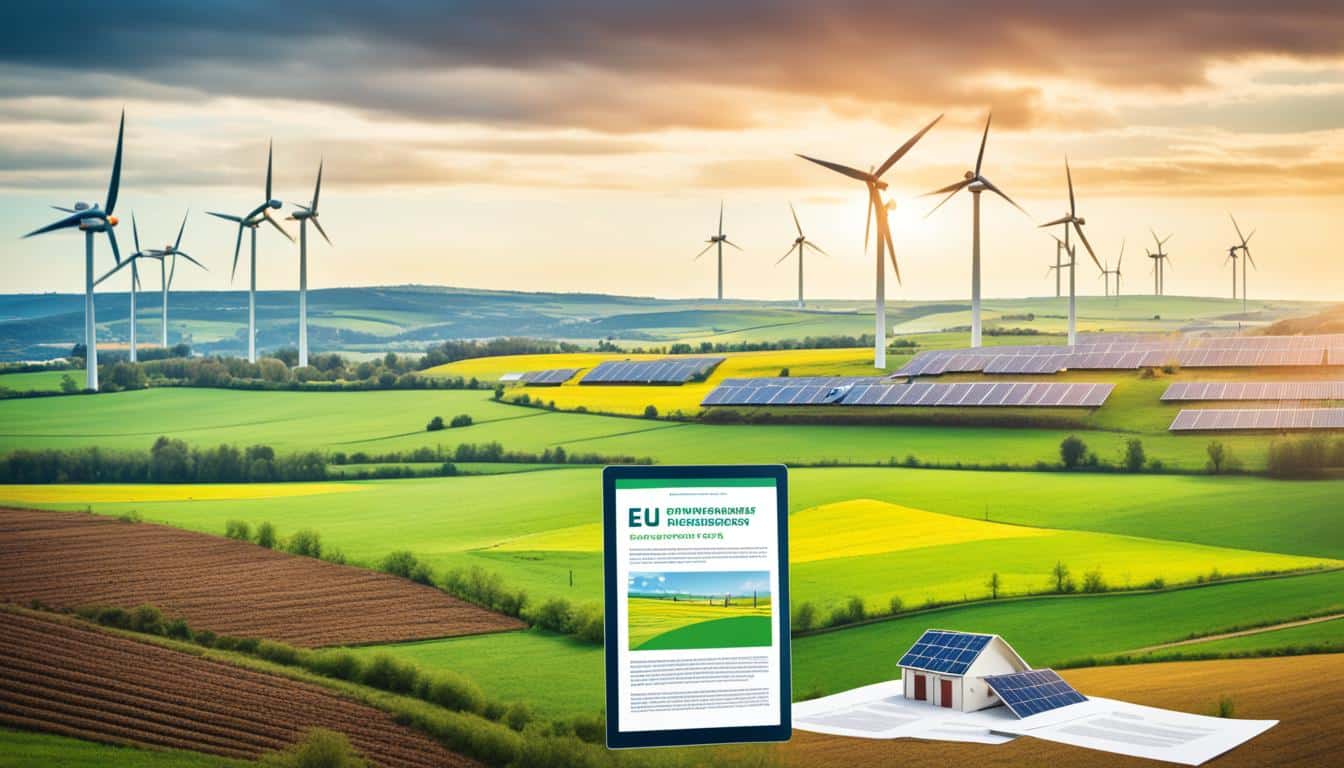
In 2020, Sweden reached a remarkable 49% in renewable energy use. This was much higher than Malta’s 10%. The difference highlights how countries in the EU are moving at their speeds towards green energy. The EU aims to have 32% energy from renewables by 2030.
The EU’s Renewable Energy Directive is part of a larger push for ‘Clean Energy for all Europeans’. It calls on farmers to make their operations greener. This means using more renewable energy and being mindful of how their work affects the climate. By following these goals, farmers play a key part in making Europe’s future more sustainable.
The EU Renewable Energy Directive guides the EU energy policy. It aims for more use of renewable energy. It also has strict rules for clean energy. This directive is key in the EU’s green energy laws. It helps member states move towards a greener, more sustainable future.
The first EU Renewable Energy Directive set 2020 targets. Each EU country had its target, from 10% to 49%. It pushed the EU to use more renewable energy. In 2018, a new directive set a 32% target for 2030. This could go higher in 2023.
RED II is the updated version. It aims to meet global challenges. By 2021, the EU wanted the 2030 target at 40%. Later, this increased to 45%. The directive aims for more renewable energy use, especially in heating, transport, and buildings.
RED II also wants to make getting permits easier. It plans for faster renewable energy projects. There are new rules to make sure bioenergy and renewables help the climate. They must match the EU’s goal for no net emissions by 2050.
The “Fit for 55” package sets even bigger climate goals for 2030. For example, it wants to cut emissions by 55% from 1990 levels. It includes new laws to push for more renewable energy. These steps strengthen the EU’s efforts to fight climate change.
The EU Renewable Energy Directive is a big part of EU policy. It works to add more renewables and follow clean energy rules. This is critical in achieving the EU’s challenging climate and energy aims.
The EU has set new goals for using more renewable energy. This move is changing how farmers use energy for their work. The idea is to make farming better for the planet while still being productive.
By 2030, the EU wants to be using over 42.5% renewable energy. They’re pushing for even more, up to 45%. This goal is a big step from the 32% needed in 2018 and the 23% used in 2022. The push is to get Europe to use much more renewable energy, cutting back on fossil fuels.
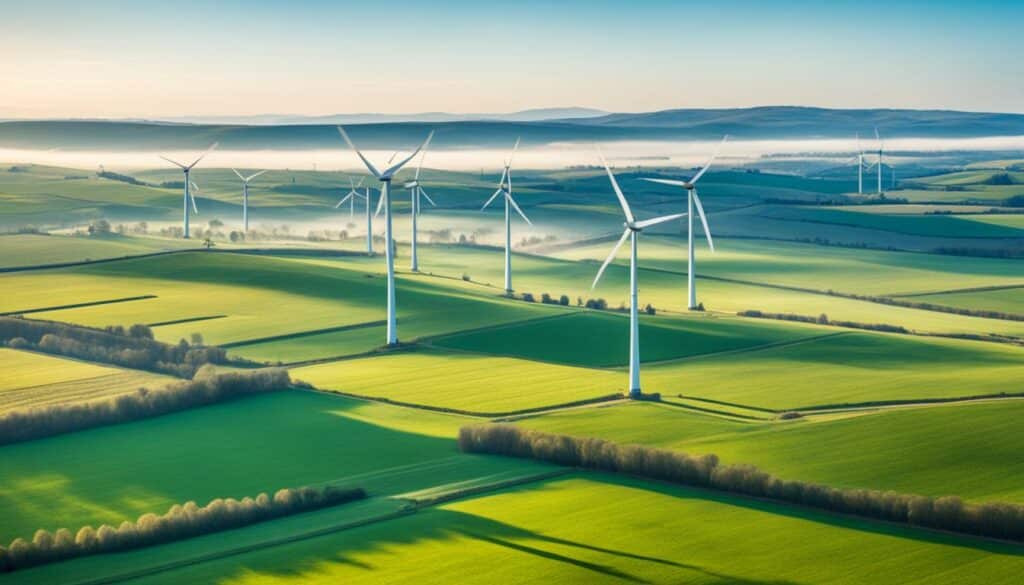
Farmers are key to making this change happen. They are asked to use more renewable energy in their daily work. Plus, they are helping to grow materials for renewable fuels. This makes farmers very important for hitting these green targets and fighting climate change.
Starting in 2023, farmers will need to change how they do things to match the EU’s targets. For example, the transport industry has to get 14% of its energy from renewables. This means farmers will have to create renewable fuels to help in these areas.
EU’s plan also includes using new methods to make biofuels. As a whole, the EU is using more renewable energy, growing from 12.5% in 2010 to 23% in 2022. Countries like Sweden, Finland, and Latvia are doing well in this area. By learning from them, farmers can hit their goals and make farming more sustainable.
The EU sees these changes as good for the environment and for coming up with new ways to use energy. Stick to these new rules, and farming will become not just greener but also more efficient.
| Country | Share of Renewables in Consumption (2022) | Future Targets for 2030 |
|---|---|---|
| Sweden | 66% | 45% |
| Finland | 47.9% | 45% |
| Latvia | 43.3% | 45% |
| EU Average | 23% | 42.5% |
The EU’s RED II leads in setting high goals. It aims to have renewable energy help the planet and cut down on gas emissions. Specific steps are taken to make sure biofuels meet tough rules to be good for the earth.
RED II looks deeply into how biofuels can affect land use. There’s worry that making biofuels might push farming into high-carbon areas. This could cancel out the good of using biofuels. The directive makes sure biofuels cut down at least 35% of gases. By 2017, this jumps to 50% and hits 60% in 2018.
The EU pushes for green energy that truly helps the planet. Producers can choose to use set values or find out their actual impact. They need to count in gases from every step, like getting the materials, growing them, making the energy, and shipping it around. The rules are being updated to fit with plans to save more gases by 2030.
RED II makes sure only soundly-produced biofuels are sold. It highlights the need for correct data along the whole supply chain. Also, it says all biofuels sold must meet green and low-risk land use rules.
Advanced biofuels are key to the EU’s renewable energy aims. They are made without affecting food production. This stops any bad side effects on the environment. These biofuels help us move forward without harming the land indirectly.
Various advanced biofuels exist, each made uniquely. They include:
Methanol, biobutanol, and other kinds of biofuels are also in the works. This broadens the renewable energy field with new technologies.
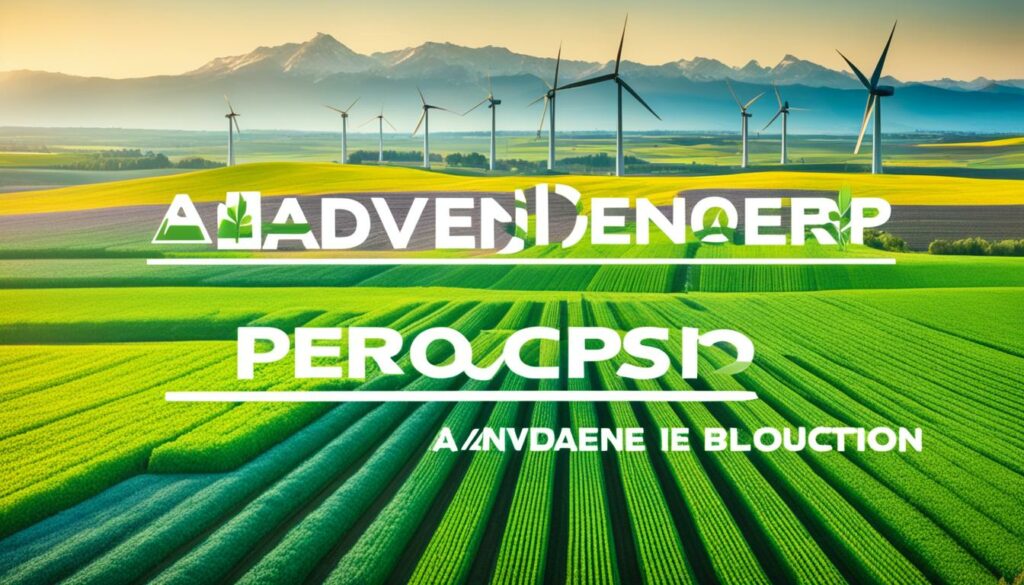
Advanced biofuels are made in many ways, showing a lot of variety. New methods in energy technology drive these processes:
The EU aims for advanced biofuels to play a big part in transport energy. They want this to grow from 0.2% in 2022 to 3.5% by 2030. These goals aim to cut greenhouse gases and boost the use of green energy.
By 2030, the EU intends to stop using high ILUC-risk biofuels completely. They are moving towards using only sustainable biofuels. In 2017, the EU used a lot of bioenergy, with 15.5 Mtoe coming from biofuels.
The EU and global groups like COM/2019/142 check which biofuels are low-risk. They work on setting high standards for biofuels. This makes sure we keep getting better and sticking to the best renewable energy practices.
| Year | Global Advanced Biofuels Production (tons/year) | Production Facilities (number) |
|---|---|---|
| 2011 | 700 million gallons | 130 |
| 2012 | 2,530,000 | Hydrotreatment primarily |
| 2017 | 99.8 Mtoe in EU28 | N/A |
The EU Renewable Energy Directive (RED II) is crucial for managing risky biofuels. Its goal is to lessen the harm of these biofuels on farming and the environment. It uses a step-by-step plan to lower negative effects.
Indirect Land Use Change (ILUC) happens when producing biofuels changes natural areas. This can lead to more carbon in the air, harming attempts to save energy. Recognising this, the RED II makes strict rules to control these risky biofuels.
The EU Directive stops high-risk biofuels from growing after 2019 till 2023. It pushes to end their use completely by 2030. This directive looks to promote biofuels that don’t harm the environment. It wants the use of farming-based energy to match broader green goals.
“The Directive limits high ILUC-risk biofuels to move towards cleaner farm energy.”
The EU provides financial help and subsidies to help farmers go green. These aim to make agriculture more sustainable. They encourage farmers to use renewable energy and reduce harmful effects on the environment. This helps the EU reach its goals for fighting climate change.

Two or more countries can work together to support clean energy projects. They provide money and land. For example, Finland and Luxembourg joined forces in February 2023. Finland allows solar projects up to 400 MW. Luxembourg is putting in €40 million. Collaboration like this is key. It helps make clean energy rules stronger and gets more people involved.
Support is given through competitive bids for projects in EU countries. This includes setting up new renewable plants and their ongoing energy production. How much money is awarded depends on how well projects compete in these bids. This helps use funds wisely.
The aid supports any technology that uses renewable energy for electricity, heating, transport, and more. Countries can also share project successes towards their renewable energy goals. This boosts teamwork.
Moreover, the EU has made rules to help member countries support clean energy without as much paperwork. This allows easier rules for energy prices in areas like hydrogen and CCS. It also helps with vehicles that don’t pollute, green buildings, and charging stations. This support lasts until 2025.
The EU and its bank are also putting more money into clean energy through various funds. An extra €25.4 billion is now going to the REPowerEU effort. These moves show the EU’s strong commitment to green energy and its global impact on saving the planet.
The EU’s Renewable Energy Directive (RED II) is key in fighting climate change. It pushes for more use of green energy and aims to cut down harmful emissions. Thanks to it, the EU has seen a big drop in greenhouse gases since 1990.
The Directive sets a goal to have 32% of the EU’s energy from renewables by 2030. It wants to make people use more wind and solar power. This will help fight climate change by using less fossil fuel.
The EU Emissions Trading System (ETS) is also important. It applies to many sites and works on a ‘cap and trade’ idea. The Effort Sharing Regulation complements it by making sure each sector reduces emissions yearly.
Member states must make plans to hit these renewable energy goals. These plans help make national and EU goals match. This teamwork strengthens efforts against climate change.
The EU’s plans to fight climate change cover many areas. Efforts on energy efficiency and using more green energy together are vital. They help the EU meet its eco-goals.
| Year | EU GHG Reduction (from 1990 levels) | Renewable Energy Target |
|---|---|---|
| 2020 | 31% | — |
| 2030 | 40% | 32% |
The EU Renewable Energy Directive plays a big part in the EU’s green future. It pushes for more clean energy and helps the planet. This Directive is shaping a better, greener world for us all.
The EU Renewable Energy Directive (RED II) has brought many challenges for farmers in Europe. It promotes renewable energy but doesn’t directly help the agricultural sector. Farmers now have to deal with new rules that affect their money and work.
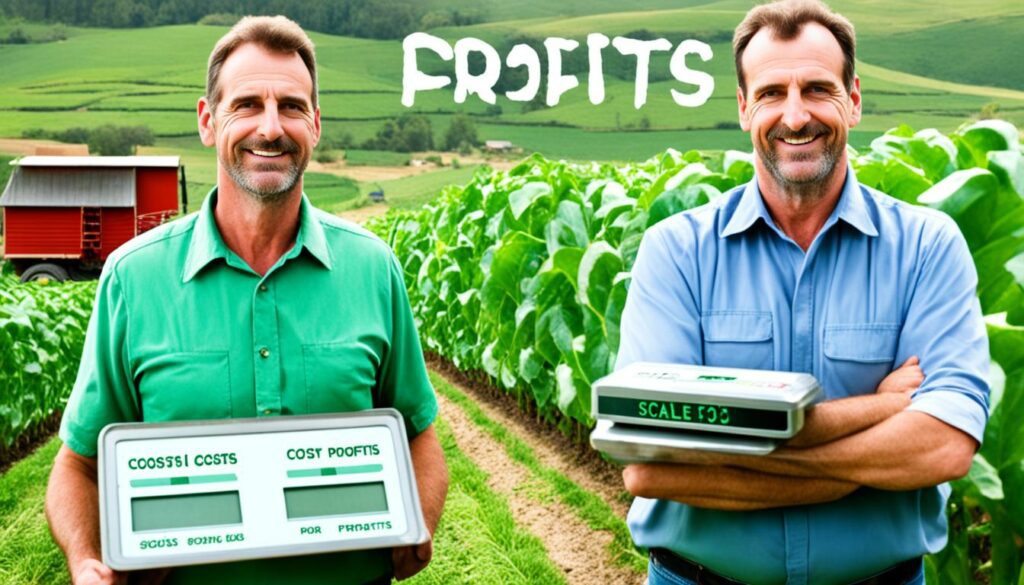
Energy and fertilisers are now more expensive. Add this to tough competition from imports, and it’s hard for European farms to make money. The new Renewable Energy Directive, launched on 4 December, sets high energy goals too.
Not talking to the folks in DG Agri has made things harder. They oversee agriculture but were left out of important biofuel discussions. This makes the rules for farming and green energy not fit together well.
Meeting the EU Renewable Energy Directive’s farming rules is tough. It requires being very green and not buying products from deforested areas. Yet, it’s hard to say which crops might cause harm to these areas.
There are also fights over rules to prevent harm in the first place, like banning certain biofuels. Big palm oil makers, such as Indonesia and Malaysia, are not happy. They might stop trading if these strict rules stay. But, others say the rules should be even tougher.
Farmers are reacting differently to the new green energy efforts. For example, in Wales, a study looked at how farmers feel about going green. This study showed that farmers’ choices and needs vary a lot. It pointed out that helping them choose the right green steps is very important.
In the end, dealing with the economic and rule changes due to the EU Directive is hard for farmers. They have to follow the laws, but they also need to stay in business. Making a green future for farming is complex but very important.
The Farm to Fork Strategy is key in the European Green Deal. It works to make our food system better by ensuring we have enough food, promoting green farming, and lowering harm to our planet. A big chunk of the world’s pollution comes from how we grow and eat our food. So, big changes are needed. The Strategy is all about tackling these issues and helping farmers make more money.
At its core, the Farm to Fork Strategy supports farming that is good for nature and people. It pushes for farm methods that save our natural resources and cut down on pollution. Its goals include bringing back lost plants and animals, fighting climate change, and getting ready for its effects. The EU is working with others around the world to make sure we all walk the same path toward a greener future.
The Strategy also has a big aim: to use fewer pesticides and not rely so much on chemical fertilisers. This change is part of the wider effort to make our food systems kinder to the environment. Money, new ideas, and working together help make this happen. Talks with countries like Colombia, Ecuador, and Peru show the world’s strong commitment to these eco-friendly farming goals. We are already seeing a positive impact from setting lower pesticide goals.
The move to renewable energy in farming is key to cut down on energy. It means using methods that don’t need as much non-renewable energy.
Farmers are essential for the EU to hit its renewable energy goals. The EU’s RED II pushes for more eco-friendly energy in farming. In 2022, the EU used 23% renewable energy, a big increase from 2010’s 12.5%. Countries like Sweden and Finland are ahead, using mostly renewable energy.
By 2022, the EU had increased its use of renewable energy to 23%, rising from 12.5% in 2010. Leading countries such as Sweden, Finland, and Latvia have 66%, 47.9%, and 43.3% renewable energy shares respectively.
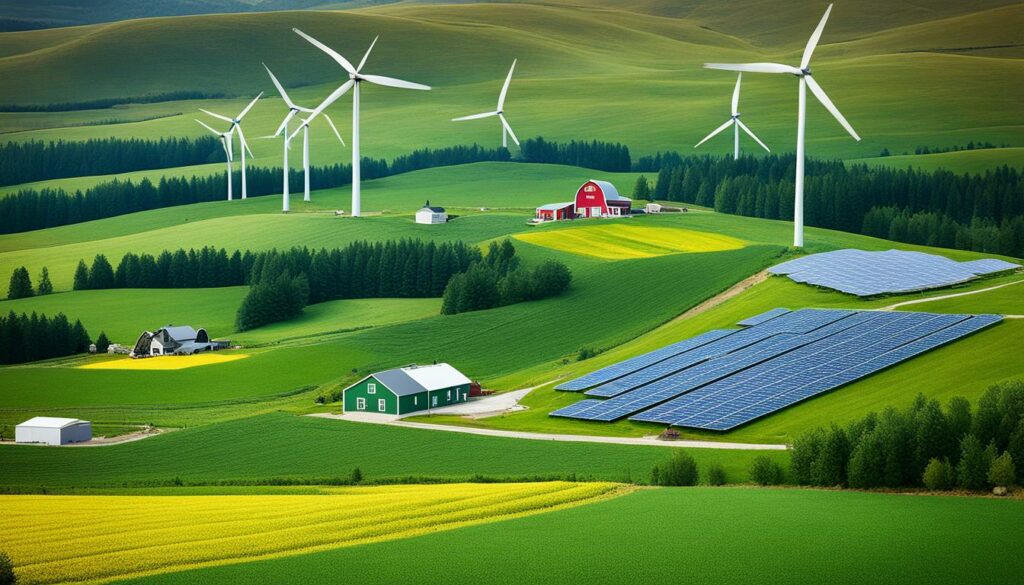
Making farming more energy efficient is vital. The RED II helps by aiming for more renewable energy use by 2030. It wants at least 42.5% coming from renewables. The EU is pushing for even higher, with a goal of 45%. This means easier ways to get permits for green projects.
With these steps, farming can use energy better, be less polluting, and last long. The EU’s target is to hit less than 1.5°C of global warming. They aim to do this by 2050, through more renewable energy use.
National renewable energy action plans are key for EU Member States to meet the goals of the Renewable Energy Directive (RED II). These plans should cover the needs of the farming sector well.
By February 2026, Member States must highlight Renewables Acceleration Areas (RAAs) under the RED. These areas aim to speed up how quickly renewable energy projects get their permits.
In RAAs, projects should get their permits in just one year. Outside RAAs, it can take up to two years. This helps meet the 2030 targets while also protecting the environment.
The European Commission is encouraging Member States to consider the environment in renewable energy plans. They want to encourage farming that’s good for nature. This fits the goal of nature-positive renewable energy.
Getting these plans to work well involves farmers and local communities from the start. This ensures that areas selected and projects launched are well-liked.
The EU has set aside a huge amount of money to support these efforts. €387 billion will go towards the Common Agricultural Policy (CAP) from 2021 to 2027. Here is a detailed breakdown of that support:
| Funding Allocation | Amount (€ Billion) | Purpose |
|---|---|---|
| European Agricultural Guarantee Fund (EAGF) | €291.1 | Direct payments to farmers |
| European Agricultural Fund for Rural Development (EAFRD) | €95.5 | Rural development initiatives |
A big focus of this funding is on helping the environment. At least 35% must go to projects that help with climate, nature, and animal welfare. This shows a strong effort towards sustainable farming.
In the end, these action plans are crucial for the EU’s green policy. They ensure that farmers can play their part in reaching the renewable energy and climate goals.
The EU’s Renewable Energy Directive (RED II) shapes how food is grown, helping food security. It asks farmers to use renewable energy and be careful of the environment. This means they need to farm in a way that doesn’t harm the planet for future generations.
Keeping up steady grain exports is key for sustainable food. Ukraine, Kazakhstan, and Russia are major grain exporting countries. Together, they used to export about 3 million tons of grain each year.Between 2017-18 and 2020-21, their exports skyrocketed, reaching over 100 million tons. By 2020-21, they shared nearly a quarter of all grain exports worldwide. Ukraine plays a large part in this, with 10 percent of the global grain trade. It highlights their importance in feeding the world.
RED II is also about cutting down wasted food. It set a target for 2 million tons of grain to be exported from Odessa port monthly. But from August to mid-November, they managed over 11 million tons. This shows they can play a big role in feeding people worldwide.
But, there are still challenges. In 2022, expected grain exports from Ukraine fell by 27 million tons. This was due to some unexpected issues. Also, they will plant less winter grain next year because of economic and political problems.
The EU aims to make food production steady with RED II. They work to fight against changes in the market and the effects of climate change. By pushing for renewable energy and green farming, they are planning for a reliable and eco-friendly food future.
The EU Renewable Energy Directive (RED II) is part of a package called ‘Clean Energy for all Europeans’. It started in December 2018. The goal is to fight climate change and protect the environment by using more renewable energy. The EU aims for 32% of its energy to come from renewable sources by 2030.
The Directive’s main aim is to boost the use of renewable energy. It also sets goals for each country to hit. By doing this, it helps fight climate change, improves renewable energy use in different places, including farms, and lowers greenhouse gas emissions.
This Directive affects farming by setting clear goals for renewable energy. It encourages farmers to use renewable energy and be more sustainable in their practices. This helps lower greenhouse gas emissions in the EU.
RED II has rules for making biofuels and biomass. It focuses on making these products in ways that are good for the planet. It asks companies to check how much they are helping the environment to pick the best methods.
Advanced biofuels come from materials that we don’t use for food and have low chances of causing harm to our environment through farming. RED II aims to use more of these biofuels, hoping they will make up 3.5% of our transport energy by 2030.
RED II says we can only use a certain amount of biofuels that might harm the environment from 2021 to 2023. This amount should be zero by 2030. Also, it pushes for checks to make sure the biofuels we use are not bad for the planet.
Yes, RED II gives farmers support if they use sustainable practices. There are rules on who can get this help. It’s meant to push farmers towards using more renewable energy and less fossil fuels, making their jobs kinder to the Earth.
Farmers can find it tough to compete with imported goods, handle higher prices for energy and fertilisers, and meet new green rules. They need to figure out how to face these issues and still do well economically. This means sticking to the Directive’s demands and staying ahead.
The Farm to Fork Strategy is part of the European Green Deal, working with RED II. It wants to make farming more eco-friendly and lower the use of chemicals. By doing this, it hopes to reach wider EU goals on sustainability.
The Directive pushes farms to use more renewable energy. It supports them in picking different energy sources and better ways to use energy. This helps make farming less harmful to our planet.
Countries need to have plans on how they will meet RED II goals. These plans should help farmers use more renewable energy and farm in ways that are better for the world. They also need to support farmers to do their best.
The Directive wants food made in ways that are good for the Earth. It tries to lower food waste and make sure we have enough safe food to eat. Farms are learning to use energy wisely while keeping our food future safe.